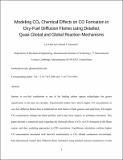Modeling CO[subscript 2] Chemical Effects on CO Formation in Oxy-Fuel Diffusion Flames Using Detailed, Quasi-Global, and Global Reaction Mechanisms
Author(s)
Chen, Lei; Ghoniem, Ahmed F.
Downloadmanuscript_revision1_f.pdf (1008.Kb)
OPEN_ACCESS_POLICY
Open Access Policy
Creative Commons Attribution-Noncommercial-Share Alike
Terms of use
Metadata
Show full item recordAbstract
Interest in oxy-fuel combustion as one of the leading carbon capture technologies has grown significantly in the past two decades. Experimental studies have shown higher CO concentration in oxy-fuel diffusion flames than in traditional air-fuel flames of both gaseous and solid fuels. The higher CO concentration changes the flame profiles, and it may have impacts on pollutants formation. This article presents a numerical study regarding the chemical effects of CO[subscript 2] on CO formation in the flame region, and their modeling approaches in CFD simulations. Equilibrium calculation confirms higher CO concentration associated with fuel-rich stoichiometry in CO[subscript 2] diluted combustion environment. One-dimensional counter-flow diffusion flame simulation using detailed reaction mechanisms reveals that the reaction H + CO[subscript 2] OH + CO enhances CO formation in the presence of high CO[subscript 2] concentration, leading to a significantly higher CO concentration under oxy-fuel combustion conditions. High CO[subscript 2] concentration also impacts the reaction OH + H[subscript 2] H + H[subscript 2]O via OH radical and results in lower H[subscript 2] and higher H[subscript 2]O concentrations in the flame profile. Computational fluid dynamics (CFD) simulations of a swirling diffusion flame under air-fired and oxy-fuel conditions were conducted using the eddy dissipation model and the eddy dissipation concept model with quasi-global and global kinetic mechanisms. Results show that reasonable CO predictions can only be obtained using finite-rate approach with appropriate mechanisms considering the CO[subscript 2] chemical effects. The Westbrook–Dryer two-step mechanism consistently underestimates the CO concentrations. In contrast, the Westbrook–Dryer multiple-step mechanism captures the chemical effects of CO[subscript 2], and improves the predictions.
Date issued
2014-01Department
Massachusetts Institute of Technology. Department of Mechanical EngineeringJournal
Combustion Science and Technology
Publisher
Taylor & Francis
Citation
Chen, Lei, and Ahmed F. Ghoniem. “Modeling CO[subscript 2] Chemical Effects on CO Formation in Oxy-Fuel Diffusion Flames Using Detailed, Quasi-Global, and Global Reaction Mechanisms.” Combustion Science and Technology 186, no. 7 (May 28, 2014): 829–848.
Version: Author's final manuscript
ISSN
0010-2202
1563-521X
